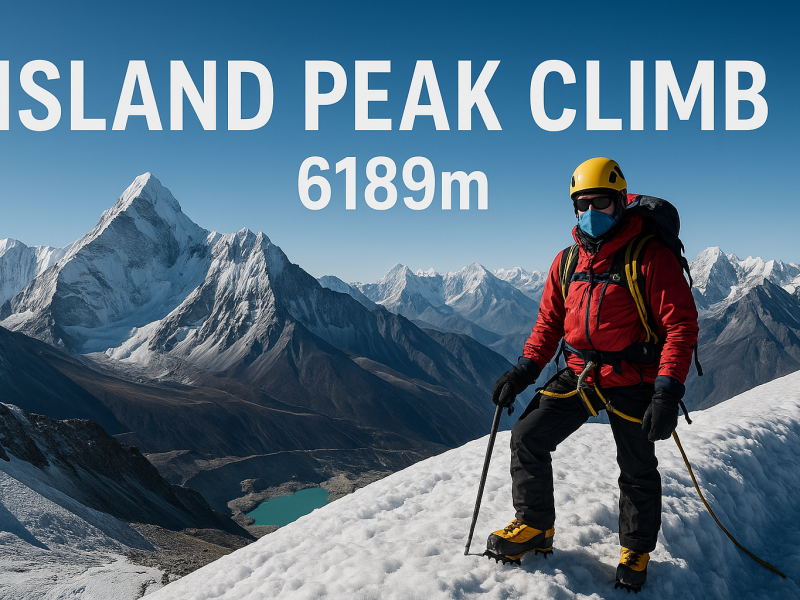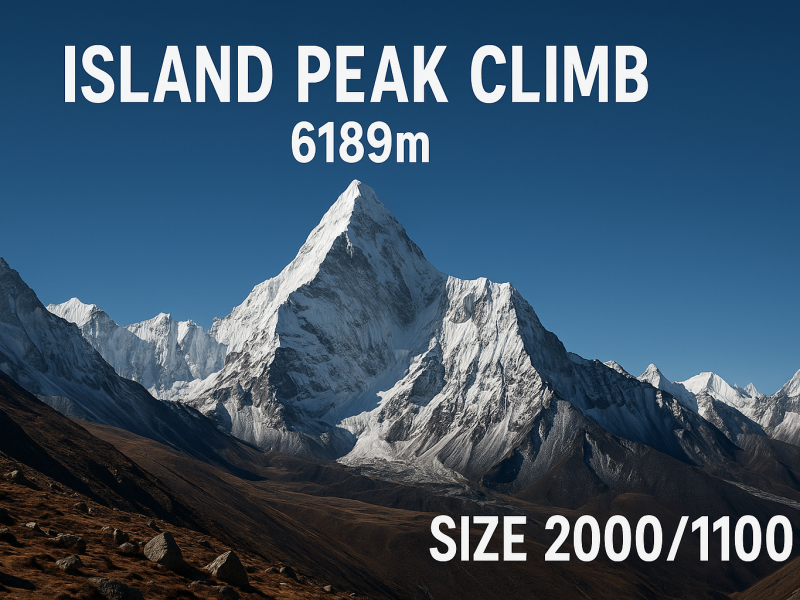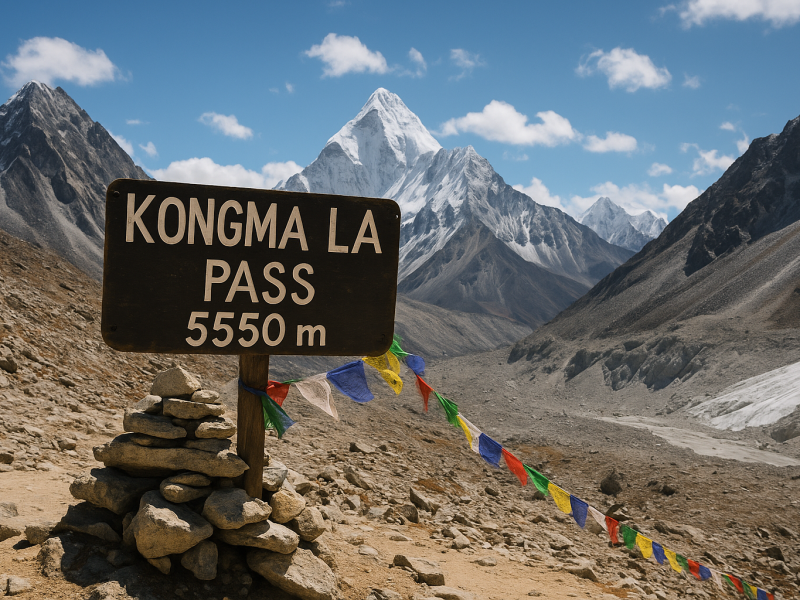
Introduction: Do You Need to Cross Kongma La to Climb Island Peak?
Island Peak Climbing (6189 meters), also known as Imja Tse, is one of the most popular trekking peaks in Nepal. Located in the Everest region, it gives climbers a great mix of adventure, mountaineering challenge, and stunning views of Himalayan giants like Lhotse, Nuptse, and Ama Dablam. Many trekkers and climbers combine Island Peak Climbing with the Everest Base Camp Trek to help with acclimatization and enjoy the classic Everest trail before heading to the summit.
One of the common questions people ask is about the route: “Do I need to cross Kongma La Pass (5550m) to climb Island Peak?” Kongma La is one of the famous Three Passes in the Everest region, along with Cho La and Renjo La. It connects Lobuche (near Everest Base Camp) with Chhukung (near Island Peak Base Camp). Some trekkers cross it as part of an extended adventure, while others take different routes.
So, is crossing Kongma La Pass required to reach Island Peak Base Camp? The simple answer is no, it is not necessary. While it’s a beautiful and adventurous route, there are other easier and more direct ways to reach Island Peak—especially if you are short on time, not doing the full Everest Three Passes Trek, or looking for a smoother path. In the following sections, we’ll explain all the route options clearly, including why or why not to take Kongma La, based on your fitness, experience, and trekking plan.
Island Peak, also called Imja Tse, is a popular climbing peak located near the small village of Chhukung in Nepal’s famous Khumbu region, close to Mount Everest. It stands at an impressive height of 6,189 meters (20,305 feet) above sea level. From far away, the mountain looks like an island rising from a sea of ice — that’s why it’s called Island Peak.
This peak is officially listed as a “trekking peak” by the Nepal Mountaineering Association, which means it’s suitable for beginner climbers — but still requires some climbing gear like ropes, harnesses, and crampons. Many climbers choose Island Peak to get high-altitude climbing experience or as part of their acclimatization before attempting Mount Everest. It’s also a great way to extend the Everest Base Camp Trek with a more adventurous goal.
Do You Need to Cross Kongma La Pass to Reach Island Peak?
A big question many trekkers and climbers ask is: “Do I need to cross Kongma La Pass (5,535 meters) to reach Island Peak?” The answer is no, it’s not necessary — but it is an option.
There are two common routes to reach Island Peak. One is through the standard Everest Base Camp route, passing through Namche, Tengboche, Dingboche, and then continuing to Chhukung without crossing the Kongma La Pass. This is the easiest and most direct route, especially if you’re not interested in high mountain passes.
The other option is more challenging. If you’re doing the Everest Three Passes Trek or want to add extra adventure, you can choose to cross Kongma La Pass (5,535m) before reaching Chhukung. This route gives you amazing mountain views but requires more stamina and is best for experienced trekkers.
Kongma La Pass, standing at an elevation of 5,550 meters, is one of the Three High Passes of the Everest region, along with Cho La Pass (5420m) and Renjo La Pass (5360m). This pass connects Lobuche (a village near Everest Base Camp) with Chhukung, which lies closer to Island Peak Base Camp. It is one of the least-used but most adventurous routes in the Everest region, offering incredible panoramic views of peaks like Lhotse, Ama Dablam, Makalu, and the Khumbu Glacier.
The Kongma La route is challenging and steep, with loose rocks and no tea houses or settlements in between. That means trekkers must be fully self-sufficient and properly acclimatized. This route is not part of the regular Island Peak climbing itinerary, but some trekkers who love adventure and want to complete the Everest Three Passes Trek include it on their way to Island Peak. So here comes the important question:
👉 Is it necessary to cross Kongma La Pass to climb Island Peak?
No, it’s not required. Most trekkers reach Island Peak via the regular Everest Base Camp route, then descend to Dingboche or Chhukung, and follow the normal trail to Island Peak Base Camp. However, if you’re looking to make your journey more thrilling and combine multiple adventures—Everest Base Camp + Kongma La + Island Peak Climb—then yes, you can cross Kongma La as part of your route.
So, if you’re fit, well-acclimatized, and want to add more challenge and beauty to your journey, crossing Kongma La is an epic choice. But if you’re focused only on Island Peak and prefer a safer, more direct route, it’s best to skip the pass.
Kongma La Pass (5,550 meters) is one of the famous Three High Passes in the Everest region of Nepal. The other two are Cho La Pass (5,420m) and Renjo La Pass (5,360m). These passes are part of the Everest Three Passes Trek, which is a challenging but rewarding trekking route for experienced hikers. Kongma La connects two popular places: Lobuche, which lies near the route to Everest Base Camp, and Chhukung, which is the gateway to Island Peak Base Camp.
However, if you are climbing Island Peak (6,189m) and not doing the full Three Passes Trek, then you do not need to cross Kongma La Pass. There is a much easier and more direct route that most climbers use. This standard route goes like this:
Kathmandu → Lukla → Namche Bazaar → Tengboche → Dingboche → Chhukung → Island Peak Base Camp. After climbing Island Peak, you can either return the same way or take a short loop via Pangboche and Tengboche before heading back to Namche and Lukla.
Crossing Kongma La is optional and only recommended if you are doing the Three Passes Trek or want an extra adventure. It’s a high and difficult pass that involves long walking days and rocky terrain. For most Island Peak climbers, avoiding Kongma La makes the journey safer and simpler, especially when you need to save your energy for the real challenge—climbing the Island Peak itself.

If you’re looking for a more adventurous and scenic way to climb Island Peak, this route is perfect for you. First, you start your journey with the Everest Base Camp Trek. This part helps you get used to the high altitude and also lets you enjoy amazing views of Mount Everest, Khumbu Glacier, and the famous Everest Base Camp at 5,364 meters. You’ll walk through beautiful Sherpa villages like Namche Bazaar, Tengboche, and Dingboche. This part of the journey already gives you an unforgettable Himalayan experience.
After Everest Base Camp, instead of going the usual route, you will cross the high Kongma La Pass (5,535 meters). This is one of the Three High Passes of the Everest region, and it connects Lobuche to Chhukung. The climb to the pass is steep and challenging, but the views from the top are worth every step. You’ll see panoramic sights of peaks like Lhotse, Makalu, and Ama Dablam. This pass is also great for high-altitude acclimatization before attempting Island Peak.
Once you reach Chhukung, you’ll continue to Island Peak Base Camp (5,100 meters). From here, your final challenge is the Island Peak Climb (6,189 meters). This full adventure — EBC + Kongma La + Island Peak — is perfect for trekkers and climbers who want more than just a regular route. It offers better acclimatization, more mountain views, and a tougher challenge. If you’re ready for a true Himalayan expedition, this is one of the best routes to choose.
Pros and Cons of Crossing Kongma La Pass (5,535m)
Kongma La is the highest and most challenging of the three passes in the Everest region. If you’re planning to climb Island Peak (6,189m), crossing Kongma La offers both benefits and challenges.
1. Better Acclimatization for Island Peak Climb
Crossing Kongma La Pass before attempting Island Peak helps your body adjust to high altitude. This is very important because Island Peak is over 6,000 meters high, and good acclimatization lowers the risk of altitude sickness. By spending more time at high elevations and gradually going higher, your body gets stronger and more used to thin air. This makes your climb to Island Peak safer and more successful.
2. Breathtaking Mountain Views
From the top of Kongma La Pass, you get to see some of the most beautiful Himalayan peaks—Lhotse, Nuptse, Ama Dablam, Makalu, and even parts of Mount Everest. These views are wide, clear, and truly unforgettable. If you love photography or simply want to enjoy raw natural beauty, this pass offers the perfect viewpoint. It’s like standing in a natural balcony above the clouds.
3. Quiet and Adventurous Route
Unlike the popular Everest Base Camp trail, Kongma La is less crowded. You’ll meet fewer people and feel closer to nature. The route is more adventurous, with rocky paths, frozen lakes, and wild landscapes. For trekkers who want a real Himalayan experience, this pass is perfect. It feels like a hidden path that only a few brave trekkers take.

Crossing Kongma La Pass (5,550m) before climbing Island Peak (6,189m) is like taking a free high-altitude training session. Your body gets better acclimatized to thin air, which reduces the risk of altitude sickness during the climb. The views from the pass are jaw-dropping—you’ll see Lhotse, Nuptse, Makalu, Ama Dablam, and other giants of the Khumbu region all around you. On top of that, this route feels wilder and more adventurous compared to the busy Everest Base Camp trail, so you get fewer crowds and more real Himalayan vibes.
Let’s be real—Kongma La is not a walk in the park. The trail is steep, rocky, and long, so you need solid stamina and some trekking experience. In bad weather—like heavy snow or storms—it can get dangerous because the path can vanish under snow or become slippery. This isn’t a place to test your luck or fitness. You’ll need proper gear, a clear plan, and a good guide who knows the route.
In short, if you’re physically fit, love a bit of challenge, and want the best acclimatization and views, crossing Kongma La Pass is worth every step. But if you’re unsure about your fitness or not used to high-altitude treks, you might want to take a simpler route. Nature Heaven Treks and Expedition can arrange safe guides, gear, and proper planning to make sure you enjoy this adventure without unnecessary risks.
Kongma La Pass (5,550m) is one of the highest and most challenging sections of the Everest region trek. It is best for trekkers who already have experience walking at high altitudes. If you’ve done treks above 4,000 meters before, and your body adjusts well to thin air, then you may enjoy the challenge of crossing Kongma La. The trail is steep, rocky, and can be snowy or icy, so it’s not a good choice for beginners or people without proper gear.
This route is perfect if you are planning to do the Everest Base Camp trek, the Three Passes Trek, and climb Island Peak (6,189m) in one big adventure. Many trekkers take this route to test themselves and enjoy the peaceful, less crowded path over Kongma La. The views from the top are stunning—you can see Lhotse, Ama Dablam, and even parts of the Khumbu Glacier.
However, if it’s your first time trekking in Nepal, or if you’re not used to walking for long hours at high altitudes, Kongma La Pass is not recommended. It’s best to go with an experienced guide who knows the route and carries safety equipment like ropes, microspikes, and navigation tools. Without proper preparation and support, this pass can be risky. If you’re unsure, consider doing Everest Base Camp without Kongma La or try easier passes like Cho La or Renjo La instead.
Tips for Safe Climbing and Crossing Kongma La Pass (5,550m)
Crossing Kongma La Pass is one of the most challenging but rewarding parts of the Everest region trek, especially if you are planning to combine it with the Island Peak Climb or the Everest Base Camp Trek. To stay safe and enjoy the journey, here are some very simple and useful tips that every trekker should follow.
1. Hire an Experienced Guide (Like Nature Heaven Treks and Expedition):
This is not a normal walking trail. Kongma La is a high-altitude, rocky, and sometimes snowy pass. The route can be confusing, especially if there is snow or fog. That’s why going with a professional and trusted trekking company like Nature Heaven Treks is highly recommended. A local guide knows the right path, the right time to start, and how to help if something goes wrong. Your safety is always the top priority.
2. Start Early, Gear Up, and Stay Prepared:
You should begin your hike over the pass early in the morning—before sunrise if possible. This helps you avoid strong winds and changing weather in the afternoon. Wear warm layers, waterproof clothes, and use trekking poles for balance. Crampons may be needed if there’s ice. Always carry water, snacks, gloves, sunglasses, and a headlamp. The weather can change quickly, so being prepared is key. This is not the place to take risks.
3. Acclimatize and Check Conditions:
Spend at least two nights in Dingboche (4,410m) or Chhukung before crossing Kongma La. This helps your body get used to the high altitude and reduces the risk of altitude sickness. Before attempting the pass, always ask your guide or local lodge about the weather and trail conditions. If there’s too much snow or wind, it’s better to wait or choose another route. Safety always comes first when trekking in high places like the Kongma La Pass.

Short answer: No, crossing Kongma La Pass is not required to climb Island Peak.
But if you want to make your journey more adventurous and exciting, adding Kongma La is a great choice.
Kongma La Pass (5,550 meters) is one of the three high passes in the Everest region. It connects Lobuche (near Everest Base Camp) to Chhukung (the gateway to Island Peak). Many trekkers choose this route to improve their acclimatization, enjoy peaceful trails, and experience breathtaking views of Everest, Lhotse, and Makalu. If you’re physically fit and have enough time, this extra challenge can make your Island Peak climbing experience more rewarding and unforgettable.
If you are planning a full Himalayan journey, we highly recommend this route:
Everest Base Camp Trek + Kongma La Pass + Island Peak Climbing.
This combination offers everything—altitude training, incredible mountain views, and a feeling of true adventure. But if you have limited time or want an easier route, you can skip Kongma La and go to Island Peak directly from Dingboche or Chhukung. Choose what suits your fitness, goals, and trekking experience. Either way, climbing Island Peak is a big achievement you’ll always remember!
“Whether you choose the peaceful Island Peak Climb (6189m) or decide to cross the adventurous Kongma La Pass (5550m) on the way, the journey will be unforgettable, full of joy, and a true Himalayan experience!”
📞 Call/WhatsApp: +977-9851218358 | +977-9841937489
📧 Email: info@natureheaventrek.com | natureheaventrek@gmail.com
📍 Address: Pakjonal Marga-16, Thamel, Kathmandu, Nepal
🌐 Website: https://natureheaventrek.com/
@Copyright 2025 Nature Heaven Treks and Expedition, Kathmandu, Nepal. All Rights Reserved.
Chat with Us